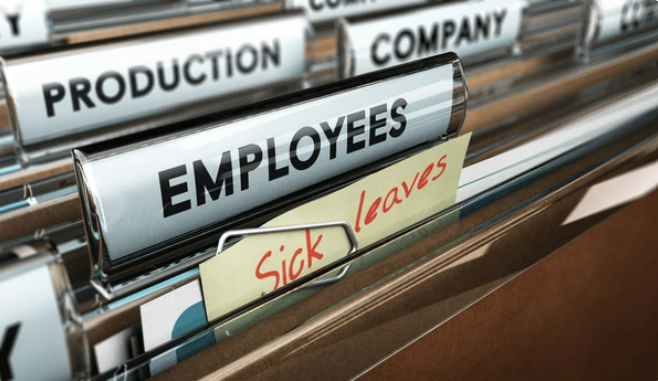✨ Health insurance, now in PayFit - learn more
💷 All the rates & thresholds you need to know for 25/26...right here
✨ The Payroll Journey: Start, Scale & Succeed Globally - learn more
✨ Health insurance, now in PayFit - learn more
💷 All the rates & thresholds you need to know for 25/26...right here
✨ The Payroll Journey: Start, Scale & Succeed Globally - learn more

Occupational sick pay covers leave that UK employees can take due to illness, including physical and mental conditions.
While Statutory Sick Pay (SSP) has increased to £118.75 per week as of the 2025/26 tax year, many companies are enhancing their occupational sick pay schemes to remain competitive.
A sick leave strategy with occupational sick pay can help you retain employees. Looking after them when they most need it shows you care about them.
Payable OSP or occupational sick pay is a benefit that UK employees are entitled to from your organisation, usually after completing their probationary period, which could be three or six months. After completing this period, they are entitled to full pay for a set number of weeks, usually moving over to half pay for another period.
What you offer in your OSP policy is entirely up to your organisation’s terms and conditions, and will be written into the employee’s employment contract.
PS: If you’re wondering what the difference between occupational sick pay and statutory sick pay is, OSP is sick pay provided by the employer, which is often in line with or exceeds SSP. While it is not mandatory to offer OSP. SSP is a basic right under law, providing the employee is eligible for SSP, and you must therefore pay this as an employer.
Like statutory sick pay, UK employees must abide by certain rules to claim occupational sick pay. However, unlike SSP, you can set your own rules for your occupational sick pay, which you’ll write into your employment contracts.
But usually, to claim your OSP, the employee might have to:
Meet your eligibility requirements detailed in your scheme
Provide a sick note from a doctor or other health professional
Correctly follow your process and procedures for claiming
For the 2025/26 tax year, employers should note:
The minimum earnings threshold for SSP eligibility is now £125 per week
SSP is payable for up to 28 weeks
Employers can no longer reclaim SSP costs
There are new requirements for documenting occupational sick pay policies
Current market trends show that competitive occupational sick pay schemes typically offer full pay for the first 3-6 months of absence, half pay for the following 3-6 months, and enhanced provisions for long-term medical conditions.
Businesses should look to offer clear return-to-work support programmes, and an effective integration of private medical insurance benefits.
Leading UK employers are implementing cloud-based leave management functionality (something PayFit helps with), mental health support provisions, as well as clear communication of enhanced benefits during recruitment.
Written sick pay policies must be provided to all employees. Clear documentation of calculation methods must also be provided for full visibility (something else PayFit helps with).
Although an OSP scheme can cost your business money, it’s ultimately worth the expense in exchange for the below benefits:
Employees want to feel valued by their employers, and, following our advice, offering an OSP policy can help you achieve that. In turn, you’ll become a desirable employer for top talent, which is something we all know you need to grow your business and compete!
If an employee is out sick for six months with a long-term health condition and without access to decent sick pay, they face stress and worry brought on by financial issues. As a UK employer, you have the power to change this, which is where a decent occupational sick pay scheme comes into play.
Many employees come into work sick, a term known as ‘presenteeism’, and it’s more prevalent since Covid with more employees working from home. Those working from home are the biggest culprits, with 81% working when unwell, compared with 65% working in an office.
Although a worrying trend, presenteeism is something 52% of HR professionals actively try to tackle and investigate potential causes.
When creating an OSP scheme, it’s up to you to decide the eligibility criteria. It’s important not to discriminate against certain employees — for example — you must offer it to part-time and full-time staff.
You might create different sick pay schemes for different levels in the company, i.e. senior leadership teams.
But you might also decide not to offer OSP in specific circumstances, i.e. elective surgeries.
Whatever you decide to offer and to whom, you need to clearly stipulate it in your sick pay scheme and make sure workers know what’s covered, what isn’t and how they can claim.
The whole point of an OSP scheme is to help your employees financially when required, so make sure your scheme is easy to understand and access when needed.
As it’s the employer’s choice to offer occupational sick pay (OSP), it’s up to you how much you offer, as long as it meets or exceeds statutory sick pay (SSP). For example, your sick pay scheme might kick in after, say, three months of employment at your company. So staff can then access a period of full pay, followed by a period of half pay — or whatever you offer in your scheme.
As of 2025, employees are entitled to £118.75 weekly in SSP for up to 28 weeks. And employees can claim this from the fourth day off sick. The exact calculation of the actual SSP entitlement for a given period can be a little complicated, which is where payroll software can definitely help.
Absenteeism costs UK businesses a lot of money. And it’s not just the cost of paying out sick pay — it’s all the other factors associated with sickness. For example, team productivity can plummet when short-staffed because they’re working extra hours to deliver work on time.
In a 2020/2021 report by HSE, 50% of work-related ill health was down to work-related stress, depression or anxiety. But the good news is that work-related ill health like this is preventable through effective absence management strategies. They can help you claw back unnecessary business costs and boost team morale and productivity.
Firstly, consider carrying out occupational health assessments. These assessments can help you understand how to best support employees struggling with ill health, whether physical or mental.
The Health and Wellbeing at Work Survey found only 56% of employees felt their organisation is supportive of mental health problems. As a UK employer, you have a duty to support your staff through difficult times.
Lead by example, encourage staff to have a positive work-life balance, assess the team’s needs and hire additional team members to support the workload. Actively promote talking about mental health openly and listen to advice to help improve the employee experience.
Using payroll software like PayFit can help you keep track of sick leave. As soon as an absence request is approved, employee payslips are updated in real-time to reflect this.
On top of this, you can use PayFit’s custom reporting feature to pinpoint patterns in absences and sickness. Maybe the team is short-staffed, or there’s a management problem. Whatever the problem, identify and rectify it quickly before it impacts your people and profit.
Schedule a demo with one of our product specialists below.

The Statutory Sick Pay is the legal minimum entitlement amount employers must pay (£118.75 per week in 2025), while Occupational Sick Pay is any enhanced sick pay scheme offered by employers above this statutory minimum.
Most employers offer enhanced sick pay for between 3-12 months, often structured as full pay for an initial period followed by a period of half pay, though this varies by industry and employer.
No, employers are only legally required to pay SSP, but many choose to offer enhanced sick pay to attract and retain employees and support wellbeing.
As a guide, it’s typically calculated as a percentage of normal salary, often 100% for an initial period followed by a reduced percentage. The exact calculation method should be clearly stated in the company’s sick pay policy.
Yes, but policy changes must be made with proper consultation and notice to employees, and cannot reduce pay below SSP levels, or affect sick pay for current absence periods.

What are KIT and SPLIT days? Get clear guidance on employer responsibilities, employee rights, payment calculations, and managing a smooth return to work.

Calculate part-time holiday entitlement in 2025-2026. Learn about calculation methods, workers' rights, and recent legislative changes for UK employers.

Understand Statutory Sick Pay (SSP) with our complete guide for UK HR & Finance leaders, covering eligibility, rates, waiting days, forms & payroll processing.

Understand UK Statutory Maternity Pay with our comprehensive guide to help growing businesses navigate SMP eligibility, rates, calculations, & HMRC claims.

Guide for HR & finance leaders of growing UK businesses on managing annual leave in 2026. Covers statutory entitlement, new holiday pay rules...

A guide to UK bank holiday employment law in 2026: Calculate entitlements and learn about flexible working impacts on bank holidays.